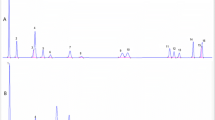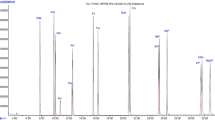Abstract
In food processing, polycyclic aromatic hydrocarbons (PAHs) can be generated during heat treatment, and the PAHs in seasoned-roasted (SR) laver can be reduced by checking points during manufacturing. Benzo (a) anthracene, chrysene, benzo (b) fluoranthene, and benzo (a) pyrene have been identified in SR laver via GC/MS. We confirmed that in practice, the PAHs in SR laver form from the mixed oil (57%) and roasting process (43%). To mitigate the formation of PAHs, we used a model system to change the mixing ratio of oil, roasting temperature, and time. A significant reduction (35%) was observed in the PAH level as the perilla oil was removed from the mixed oil composition and roasting continued at 350 °C for 10 s. These results show that the composition of the mixing oil and the parameters of the heat treatment are crucial factors that contribute to the formation of PAHs in roasted laver.


Similar content being viewed by others
References
Alomirah H, Al-Zenki S, Husain A, Sawaya W, Ahmed N, Gevao B, Kannan K. Benzo [a] pyrene and total polycyclic aromatic hydrocarbons (PAHs) levels in vegetable oils and fats do not reflect the occurrence of the eight genotoxic PAHs. Food Addit. Contam. B. 27: 869–878 (2010)
Bartle K. Analysis and occurrence of polycyclic aromatic hydrocarbons in food. pp. 41–60 in Food contaminants: Sources and surveillance. C.S. Creaser and R. Purchase (ed). The Royal Society of Chemistry, Cambridge, UK (1991)
Chung J, Choe E. Effects of sesame oil on thermooxidative stability of soybean oil. Food Sci. Biotechnol. 10: 446–450 (2001)
Commission Regulation (EU). No 835/2011 of 19 August amending Regulation (EC) No 1881/2006 as regards maximum levels for polycyclic aromatic hydrocarbons in foodstuffs. Available from: http://eur-lex.europa.eu/legal-content/EN/TXT/?uri=CELEX:329011Ro835. Accessed Dec 19, 2016
De Kruijf N, Schouten T, Van der Stegen GH. Rapid determination of benzo [a] pyrene in roasted coffee and coffee brew by high-performance liquid chromatography with fluorescence detection. J. Agric. Food Chem. 35: 545–549 (1987)
Detwiler S, Markley K. Smoke, flash, and fire points of soybean and other vegetable oils. Oil Soap 17: 39–40 (1940)
Domingo JL, Nadal M. Human dietary exposure to polycyclic aromatic hydrocarbons: A review of the scientific literature. Food Chem. Toxicol. 86: 144–153 (2015)
Dost K, İdeli C. Determination of polycyclic aromatic hydrocarbons in edible oils and barbecued food by HPLC/UV–Vis detection. Food Chem. 133: 193–199 (2012)
Hu X, Herzog C, Zimniak P, Singh SV. Differential protection against benzo [a] pyrene-7, 8-dihydrodiol-9, 10-epoxide-induced DNA damage in HepG2 cells stably transfected with allelic variants of π class human glutathione S-transferase. Cancer Res. 59: 2358–2362 (1999)
IARC. Diesel and gasoline engine exhaust and some nitroarenes. IARC monographs on the Evaluation of the Carcinogenic Risk of chemicals to Humans, France (1989)
Jägerstad M, Skog K. Genotoxicity of heat-processed foods. Mutat. Res. Fund. Mol. M. 574: 156–172 (2005)
Jennings BH, Akoh CC. Characterization of a rice bran oil structured lipid. J. Agric. Food Chem. 57: 3346–3350 (2009)
Jo EJ, Kang SJ, Kim AJ. Effects of steam-and dry-processing temperatures on the benzo (a) pyrene content of black and red ginseng. Korean J. Food Nutr. 22: 199–204 (2009) (in Korean language)
Kazerouni N, Sinha R, Hsu CH, Greenberg A, Rothman N. Analysis of 200 food items for benzo [a] pyrene and estimation of its intake in an epidemiologic study. Food Chem. Toxicol. 39: 423–436 (2001)
Kim I, Choe E. Effects of bleaching on the properties of roasted sesame oil. J. Food Sci. 70: C48–C52 (2005)
Kim KJ, Choi SH, Park KH. Factors affecting concentration of polycyclic aromatic hydrocarbons in Oyster, Laver and Rockfish. Korean J. Malacol. 24: 253–260 (2008)
Larionow L, Soboleva N. Gastric tumors experimental produced in mice by means of benzopyrene and dibenzanthracene. Vestn. Rentgenol. Radiol. 20: 276 (1938)
Larsson BK, Sahlberg GP, Eriksson AT, Busk LA. Polycyclic aromatic hydrocarbons in grilled food. J. Agric. Food Chem. 31: 867–873 (1983)
Lee JG, Kim SY, Moon JS, Kim SH, Kang DH, Yoon HJ. Effects of grilling procedures on levels of polycyclic aromatic hydrocarbons in grilled meats. Food Chem. 199: 632–638 (2016)
Li N, Luo H, Jia Y, Zhou N, Li Y. Rapid determination of benzo (a) pyrene in processed meat and fish samples by second-derivative constant-energy synchronous fluorescence spectrometry. Food Addit. Contam. 28: 235–242 (2011)
Lu F, Kuhnle GK, Cheng Q. Vegetable oil as fat replacer inhibits formation of heterocyclic amines and polycyclic aromatic hydrocarbons in reduced fat pork patties. Food Control 81: 113–125 (2017)
MFDS. The Ministry of Food and Drug Safety, Republic of Korea. Available from: http://mfds.go.kr/index.do?x=0&searchkey=title:contents&mid=695&searchword=%BA%A5%C1%B6%C7%C7%B7%BB&cd=&y=0&pageNo=1&seq=11407&cmd=v. Accessed 2011
Moret S, Conte LS. Polycyclic aromatic hydrocarbons in edible fats and oils: occurrence and analytical methods. J. Chromatogr. A 882: 245–253 (2000)
Moret S, Dudine A, Conte L. Processing effects on the polyaromatic hydrocarbon content of grapeseed oil. J. Am. Oil Chem. Soc. 77: 1289–1292 (2000)
Morgan D. Smoke, fire, and flash points of cottonseed, peanut, and other vegetable oils. Oil Soap 19: 193–198 (1942)
Park SY, Kang S, Ha SD. Antimicrobial effects of vinegar against norovirus and Escherichia coli in the traditional Korean vinegared green laver (Enteromorpha intestinalis) salad during refrigerated storage. Int. J. Food Microbiol. 238: 208–214 (2016)
Phillips DH. Polycyclic aromatic hydrocarbons in the diet. Mutat. Res. Fund. Mol. M. 443: 139–147 (1999)
Rengarajan T, Rajendran P, Nandakumar N, Lokeshkumar B, Rajendran P, Nishigaki I. Exposure to polycyclic aromatic hydrocarbons with special focus on cancer. Asian Pac. J. Trop. Med. 5: 182–189 (2015)
Sarwar A, Vunguturi S, Ferdose A. A study on smoke point and peroxide values of different widely used edible oils. Int. J. Eng. Technol. Sci. Res. 3:271 (2016)
Scientific Committee on Food. Opinion of the Scientific Committee on Food on the risks to human health of Polycyclic Aromatic Hydrocarbons in food. Available from: https://europa.eu.int/comm/food/fs/sc/scf/index_en.html/. Accessed 2002
Shi LK, Zhang DD, Liu YL. Incidence and survey of polycyclic aromatic hydrocarbons in edible vegetable oils in China. Food Control 62: 165–170 (2016)
Speer K, Steeg E, Horstmann P, Kühn T, Montag A. Determination and distribution of polycyclic aromatic hydrocarbons in native vegetable oils, smoked fish products, mussels and oysters, and bream from the river Elbe. J. High Res. Chromatog. 13: 104–111 (1990)
Taverniers I, De Loose M, Van Bockstaele E. Trends in quality in the analytical laboratory. II. Analytical method validation and quality assurance. TrAC Trend. Anal. Chem. 23: 535–552 (2004)
Uno S, Dalton TP, Derkenne S, Curran CP, Miller ML, Shertzer HG, Nebert DW. Oral exposure to benzo [a] pyrene in the mouse: detoxication by inducible cytochrome P450 is more important than metabolic activation. Mol. Pharmacol. 65: 1225–1237 (2004)
Wang G, Lee AS, Lewis M, Kamath B, Archer RK. Accelerated solvent extraction and gas chromatography/mass spectrometry for determination of polycyclic aromatic hydrocarbons in smoked food samples. J. Agric. Food Chem. 47: 1062–1066 (1999)
Yoon E, Park K, Lee H, Yang JH, Lee C. Estimation of excess cancer risk on time-weighted lifetime average daily intake of PAHs from food ingestion. Hum. Ecol. Risk Asses. 13(3): 669–680 (2007)
Acknowledgements
This research was supported by Korea University Grant (K1327111), and School of Life Sciences & Biotechnology of Korea University for BK21PLUS. The authors thank the Institute of Biomedical Science & Food Safety, CJ-Korea University Food Safety Hall (Seoul, South Korea) for providing the equipment and facilities.
Author information
Authors and Affiliations
Corresponding author
Ethics declarations
Conflict of interest
None of the authors of this study has any financial interest or conflict with industries or parties.
Additional information
Publisher's Note
Springer Nature remains neutral with regard to jurisdictional claims in published maps and institutional affiliations.
Electronic supplementary material
Below is the link to the electronic supplementary material.
Rights and permissions
About this article
Cite this article
Kang, SJ., Yang, SY., Lee, JW. et al. Polycyclic aromatic hydrocarbons in seasoned-roasted laver and their reduction according to the mixing ratio of seasoning oil and heat treatment in a model system. Food Sci Biotechnol 28, 1247–1255 (2019). https://doi.org/10.1007/s10068-019-00569-w
Received:
Revised:
Accepted:
Published:
Issue Date:
DOI: https://doi.org/10.1007/s10068-019-00569-w




